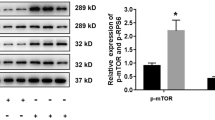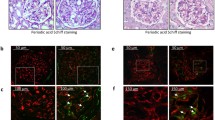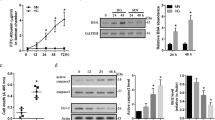Abstract
Despite growing evidence for a pathogenic role of vascular endothelial growth factor (VEGF) in microvascular complications of diabetes, the underlying mechanism responsible for its detrimental effect remains unknown. In the current study, we hypothesized that some of the detrimental effects of VEGF on microvascular endothelial cells in the diabetic milieu stem from its aberrant signaling, which leads to perturbed tight junction assembly and increased endothelial permeability. Using an integrated in vitro approach, we investigated whether the effect of VEGF on endothelial cell permeability involves Rac1 GTPase activation and tight junction disassembly. Rac1 activity was detected by Western blotting in cell membrane protein as well as pull-down assay. The permeability of glomerular endothelial cells monolayer was detected as transendothelial electronic resistance. Then tyrosine phosphorylated occludin protein was detected by Western blotting after immunoprecipitation. N17Rac1 cells are obtained by transfection of glomerular endothelial cells with a dominant negative mutant of Rac1. The data obtained in this study indicate that activation of Rac1 GTPase contributes to VEGF-induced endothelial cell hyperpermeability. We also observed that Rac1 activation leads to increased endothelial permeability through tyrosine phosphorylation of occludin. Indeed, N17Rac1 cells dramatically attenuated the effect of VEGF on phospho-occludin and endothelial cell permeability. These results, when taken together, provide a framework for understanding the role of VEGF-induced Rac1/phospho-occludin pathway in the integrity of endothelial barrier function in the glomerulus.




Similar content being viewed by others
References
Houck KA, Ferrara N, Winer J, Cachianes G, Li B, Leung DW (1991) The vascular endothelial growth factor family: identification of a fourth molecular species and characterization of alternative splicing of RNA. Mol Endocrinol 5:1806–1814
Neufeld G, Cohen T, Gengrinovitch S, Poltorak Z (1999) Vascular endothelial growth factor (VEGF) and its receptors. FASEB J 13:9–22
Simon M, Rockl W, Hornig C, Grone EF, Theis H, Weich HA, Fuchs E, Yayon A, Grone HJ (1998) Receptors of vascular endothelial growth factor/vascular permeability factor (VEGF/VPF) in fetal and adult human kidney: localization and [125I]VEGF binding sites. J Am Soc Nephrol 9:1032–1044
Cha DR, Kang YS, Han SY, Jee YH, Han KH, Han JY, Kim YS, Kim NH (2004) Vascular endothelial growth factor is increased during early stage of diabetic nephropathy in type II diabetic rats. J Endocrinol 183:183–194
Cooper ME, Vranes D, Youssef S, Stacker SA, Cox AJ, Rizkalla B, Casley DJ, Bach LA, Kelly DJ, Gilbert RE (1999) Increased renal expression of vascular endothelial growth factor (VEGF) and its receptor VEGFR-2 in experimental diabetes. Diabetes 48:2229–2239
Balda MS, Matter K (2000) The tight junction protein ZO-1 and an interacting transcription factor regulate ErbB-2 expression. EMBO J 19:2024–2033
Li D, Mrsny RJ (2000) Oncogenic Raf-1 disrupts epithelial tight junctions via downregulation of occludin. J Cell Biol 148:791–800
Harhaj NS, Antonetti DA (2004) Regulation of tight junctions and loss of barrier function in pathophysiology. Int J Biochem Cell Biol 36:1206–1237
Saitou M, Fujimoto K, Doi Y, Itoh M, Fujimoto T, Furuse M, Takano H, Noda T, Tsukita S (1998) Occludin-deficient embryonic stem cells can differentiate into polarized epithelial cells bearing tight junctions. J Cell Biol 141:397–408
Mitic LL, Anderson JM (1998) Molecular architecture of tight junctions. Annu Rev Physiol 60:121–142
Wong V (1997) Phosphorylation of occludin correlates with occludin localization and function at the tight junction. Am J Physiol Cell Physiol 273:C1859–C1867
Chen Y-H, Lu Q, Goodenough DA, Jeansonne B (2002) Nonreceptor tyrosine kinase c-Yes interacts with occludin during tight junction formation in canine kidney epithelial cells. Mol Biol Cell 13:1227–1237
Gonzalez-Mariscal L, Betanzos A, Nava P, Jaramillo BE (2003) Tight junction proteins. Prog Biophys Mol Biol 81:1–44
Sakakibara A, Furuse M, Saitou M, Ando-Akatsuka Y, Tsukita S (1997) Possible involvement of phosphorylation of occludin in tight junction formation. J Cell Biol 137:1393–1401
Tsukamoto T, Nigam SK (1999) Role of tyrosine phosphorylation in the reassembly of occludin and other tight junction proteins. Am J Physiol Renal Physiol 276:F737–F750
Seth A, Sheth P, Elias BC, Rao R (2007) Protein phosphatases 2A and 1 interact with occludin and negatively regulate the assembly of tight junctions in the CACO-2 cell monolayer. J Biol Chem 282:11487–11498
Sheth P, Basuroy S, Li C, Naren AP, Rao RK (2003) Role of phosphatidylinositol 3-kinase in oxidative stress-induced disruption of tight junctions. J Biol Chem 278:49239–49245
Andreeva AY, Krause E, Muller E-C, Blasig IE, Utepbergenov DI (2001) Protein kinase C regulates the phosphorylation and cellular localization of occludin. J Biol Chem 276:38480–38486
Cordenonsi M, Mazzon E, De Rigo L, Baraldo S, Meggio F, Citi S (1997) Occludin dephosphorylation in early development of Xenopus laevis. J Cell Sci 110:3131–3139
Cordenonsi M, Turco F, D’Atri F, Hammar E, Martinucci G, Meggio F, Citi S (1999) Xenopus laevis occludin: identification of in vitro phosphorylation sites by protein kinase CK2 and association with cingulin. Eur J Biochem 264:374–384
Kale G, Naren AP, Sheth P, Rao RK (2003) Tyrosine phosphorylation of occludin attenuates its interactions with ZO-1, ZO-2, and ZO-3. Biochem Biophys Res Commun 302:324–329
Bazzoni G, Dejana E (2004) Endothelial cell-to-cell junctions: molecular organization and role in vascular homeostasis. Physiol Rev 84:869–901
Bruewer M, Hopkins AM, Hobert ME, Nusrat A, Madara JL (2004) RhoA, Rac1, and Cdc42 exert distinct effects on epithelial barrier via selective structural and biochemical modulation of junctional proteins and F-actin. Am J Physiol Cell Physiol 287:C327–C335
Hopkins AM, Walsh SV, Verkade P, Boquet P, Nusrat A (2003) Constitutive activation of Rho proteins by CNF-1 influences tight junction structure and epithelial barrier function. J Cell Sci 116:725–742
Jacobson JR, Dudek SM, Singleton PA, Kolosova IA, Verin AD, Garcia JGN (2006) Endothelial cell barrier enhancement by ATP is mediated by the small GTPase Rac and cortactin. Am J Physiol Lung Cell Mol Physiol 291:L289–L295
Nusrat A, Giry M, Turner JR, Colgan SP, Parkos CA, Carnes D, Lemichez E, Boquet P, Madara JL (1995) Rho protein regulates tight junctions and perijunctional actin organization in polarized epithelia. Proc Natl Acad Sci USA 92:10629–10633
Aznar S, Lacal J (2001) Rho signals to cell growth and apoptosis. Cancer Lett 165:1–10
Bar-Sagi D, Hall A (2000) Ras and Rho GTPases: a family reunion. Cell 103:227–238
Bishop A, Hall A (2000) Rho GTPases and their effector proteins. Biochem J 348(Pt 2):241–255
Brown JH, Del Re DP, Sussman MA (2006) The Rac and Rho hall of fame: a decade of hypertrophic signaling hits. Circ Res 98:730–742
Burridge K, Wennerberg K (2004) Rho and Rac take center stage. Cell 116:167–179
Zeng L, Xu H, Chew T-L, Eng E, Sadeghi MM, Adler S, Kanwar YS, Danesh FR (2005) HMG CoA reductase inhibition modulates VEGF-induced endothelial cell hyperpermeability by preventing RhoA activation and myosin regulatory light chain phosphorylation. FASEB J 19(13):1845–1847
Jacobson JR, Dudek SM, Birukov KG, Ye SQ, Grigoryev DN, Girgis RE, Garcia JGN (2004) Cytoskeletal activation and altered gene expression in endothelial barrier regulation by Simvastatin. Am J Respir Cell Mol Biol 30:662–670
Wojciak-Stothard B, Ridley AJ (2002) Rho GTPases and the regulation of endothelial permeability. Vascul Pharmacol 39(4–5):187–199
Wojciak-Stothard B, Tsang LYF, Haworth SG (2005) Rac and Rho play opposing roles in the regulation of hypoxia/reoxygenation-induced permeability changes in pulmonary artery endothelial cells. Am J Physiol Lung Cell Mol Physiol 288:L749–L760
Wojciak-Stothard B, Potempa S, Eichholtz T, Ridley AJ (2001) Rho and Rac but not Cdc42 regulate endothelial cell permeability. J Cell Sci 114:1343–1355
Wojciak-Stothard B, Tsang LYF, Paleolog E, Hall SM, Haworth SG (2006) Rac1 and RhoA as regulators of endothelial phenotype and barrier function in hypoxia-induced neonatal pulmonary hypertension. Am J Physiol Lung Cell Mol Physiol 290:L1173–L1182
van Wetering S, van Buul JD, Quik S, Mul FPJ, Anthony EC, J-Pt Klooster, Collard JG, Hordijk PL (2002) Reactive oxygen species mediate Rac-induced loss of cell–cell adhesion in primary human endothelial cells. J Cell Sci 115:1837–1846
Vouret-Craviari V, Boquet P, Pouyssegur J, Van Obberghen-Schilling E (1998) Regulation of the actin cytoskeleton by thrombin in human endothelial cells: role of Rho proteins in endothelial barrier function. Mol Biol Cell 9:2639–2653
Clarke H, Soler AP, Mullin JM (2000) Protein kinase C activation leads to dephosphorylation of occludin and tight junction permeability increase in LLC-PK1 epithelial cell sheets. J Cell Sci 113:3187–3196
Vouret-Craviari V, Bourcier C, Boulter E, Van Obberghen-Schilling E (2002) Distinct signals via Rho GTPases and Src drive shape changes by thrombin and sphingosine-1-phosphate in endothelial cells. J Cell Sci 115:2475–2484
Jou T-S, Schneeberger EE, James Nelson W (1998) Structural and functional regulation of tight junctions by RhoA and Rac1 small GTPases. J Cell Biol 142:101–115
Saitou M, Furuse M, Sasaki H, Schulzke J-D, Fromm M, Takano H, Noda T, Tsukita S (2000) Complex phenotype of mice lacking occludin, a component of tight junction strands. Mol Biol Cell 11:4131–4142
Shin K, Fogg VC, Margolis B (2006) Tight junctions and cell polarity. Annu Rev Cell Dev Biol 22:207–235
Balda MS, Whitney JA, Flores C, Gonzalez S, Cereijido M, Matter K (1996) Functional dissociation of paracellular permeability and transepithelial electrical resistance and disruption of the apical- basolateral intramembrane diffusion barrier by expression of a mutant tight junction membrane protein. J Cell Biol 134:1031–1049
Farshori P, Kachar B (1999) Redistribution and phosphorylation of occludin during opening and resealing of tight junctions in cultured epithelial cells. J Membr Biol 170:147–156
Antonetti DA, Barber AJ, Hollinger LA, Wolpert EB, Gardner TW (1999) Vascular endothelial growth factor induces rapid phosphorylation of tight junction proteins occludin and zonula occluden: a potential mechanism for vascular permeability in diabetic retinopathy and tumors. J Biol Chem 274:23463–23467
Acknowledgments
We are grateful to Teng-Leong Chow and Satya Khuon for their helpful discussions and technical support. This project was funded by the National Natural Science Foundation of China (No.30771011) and Guangdong Natural Science Foundation (No. 06300757).
Author information
Authors and Affiliations
Corresponding author
Rights and permissions
About this article
Cite this article
Peng, H., Wang, C., Ye, Zc. et al. How increased VEGF induces glomerular hyperpermeability: a potential signaling pathway of Rac1 activation. Acta Diabetol 47 (Suppl 1), 57–63 (2010). https://doi.org/10.1007/s00592-009-0121-8
Received:
Accepted:
Published:
Issue Date:
DOI: https://doi.org/10.1007/s00592-009-0121-8




